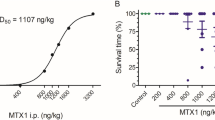Abstract
Acute toxicity and metabolism of seven dinitriles in mice was studied in relation to the chemical structures. The oral LD50 for each nitrile was determined under different conditions for mice pretreated with either carbon tetrachloride (CCl4) or olive oil. All test nitriles were metabolized into cyanide in vivo and in vitro. The cyanide level was variable among the compounds (0.35–0.74 μg CN/g brain) at death in the brains of mice, the level for malono- and adiponitrile being comparable to that found in mice killed by dosing with potassium cyanide. After receiving each nitrile, the mean survival time of mice pretreated with CCl4 was prolonged and their brain cyanide level decreased when compared with the corresponding control. With malononitrile, the former did not significantly change and the latter decreased slightly. Brain cyanide levels of control mice at death showed a peak at the lower log P region, while those of CCl4-pretreated animals remained lower independently of log P, with the exception of malononitrile. Microsomal metabolism of nitriles to cyanide was greatly inhibited when microsomes were prepared from livers of mice pretreated with CCl4. The relationship between log (1/LD50-CCl4), LD50 in mice pretreated with CCl4, and log P fits a parabolic plot.
Similar content being viewed by others
References
Bruce RB, Howard JW, Hanzal RF (1955) Determination of cyanide, thiocyanate, and alpha-hydroxynitriles in plasma orserum. Anal Chem 27: 1346–1347
Castro JA, Diaz-Gomez MI, De Ferreyra EC, De Castro CR, D'Acosta N, De Fenos OM (1972) Carbon tetrachloride effect on rat liver and adrenals related to their mixed function oxygenase content. Biochem Biophys Res Commun 47: 315–321
Cavanna R, Pocchiari F (1972) Fate of succinonitrile-1-14C in the mouse. Biochem Pharmacol 21: 2529–2531
Contessa AR, Santi R (1973) Liberation of cyanide from succinonitrile. Biochem Pharmacol 22: 827–832
Curry SH (1975) Cumulative excretion of succinonitrile in mice. Biochem Pharmacol 24: 351–354
Epstein J (1947) Estimation of microquantities of cyanide. AnalChem 19: 272–274
Glende EA (1972) On the mechanism of carbon tetrachloride toxicity-coincidence of loss of drug-metabolizing activity withperoxidation of microsomal lipid. Biochem Pharmacol 21: 2131–2138
Glende EA, Hruszkewycz AM, Recknagel RO (1976) Critical role of lipid peroxidation in carbon tetrachloride-induced loss of aminopyrine demethylase, cytochrome P-450 and glucose-6-phosphatase. Biochem Pharmacol 25: 2163–2170
Hansch C, Fujita T (1969) π-σ-π-Analysis. A method for the correlation of biological activity and chemical structure. J Am Chem Soc 86: 1616–1626
Hansch C (1971) Quantitative structure-activity relationships in drug design. In: Ariens EJ (ed) Drug design. Academic Press, New York, pp 271–342
Hartung OR (1982) Cyanides and nitriles. In: Clayton GD, Clayton FE (eds) Patty's industrial hygiene and toxicology. Wiley-Interscience Publication, New York, pp 4845–4900
Hjelle JJ, Grubbs JH, Beer DG, Petersen DR (1981) Inhibition of rat liver aldehyde dehydrogenase by carbon tetrachloride. J Pharmacol Exp Ther 219: 821–826
Kopecký J, Gut I, Nerudová J, Zachardova D, Holeček V (1981) Metabolic study on acrylonitrile. In: Gut I, Cikrt M, Plaa GL (eds) Industrial and environmental xenobiotics. Springer, Berlin Heidelberg New York, pp 221–229
Lowry OH, Rosebrough NJ, Farr AL, Randall RJ (1951) Protein measurement with the folin phenol reagent. J Biol Chem 193: 265–275
NIOSH, National Institute for Occupational Safety and Health Criteria and Recommended Standard for Nitriles, U.S. Dept. Health, Education and Welfare, Center for Disease Control, U.S. Govt. Printing Office, Washington, DC 1978
Noguchi T, Fong KL, Lai EK, Olsen L, McCay PB (1982) Selective early loss of polypeptides in liver microsomes of CCl4-treated rats. Relationship to cytochrome P-450 content. Biochem Pharmacol 31: 609–614
Sasame HA, Castro JA, Gillette JR (1968) Studies on the destruction of liver microsomal cytochrome P-450 by carbon tetrachloride administration. Biochem Pharmacol 17: 1759–1768
Silver EH, Kuttab SH, Hasan T, Hassan M (1982) Structural considerations in the metabolism of nitriles to cyanide in vivo. Drug Metab Dispos 10: 495–498
Stern J, Weil-Malherbe H, Green RH (1952) The effects and the fate of malononitrile and related compounds in animal tissues. Biochem J 52: 114–125
Tanii H, Hashimoto K (1981) Studies on in vitro metabolism of acrylamide and related compounds. Arch Toxicol 48: 157–166
Tanii H, Hashimoto K (1982) Structure-toxicity relationship of acrylates and methacrylates. Toxicol Lett 11: 125–129
Tanii H, Hashimoto K (1984 a) Studies on the mechanism of acute toxicity of nitriles in mice. Arch Toxicol 55: 47–54
Tanii H, Tsuji H, Hashimoto K (1985) Structure-acute toxicity relationship of monoketones. Toxicol Lett (in press)
Tanii H, Hashimoto K (1984 b) Structure-toxicity relationship of aliphatic nitriles. Toxicol Lett 22: 267–272
Teschke R, Vierke W, Goldermann L (1983) Carbon tetrachloride (CCl4) levels and serum activities of liver enzymes following acute CCl4 intoxication. Toxicol Lett 17: 175–180
Tullar PE (1947) Final report on the pharmacology and toxicology of acrylonitrile and acrylon. Kalusowski Memorial Research Laboratories, George Washington University
Weil CS (1952) Tables for convenient calculation of median effective dose (LD50 or ED50) and instructions in their use. Biometrics 8: 249–263
Willhite CC, Smith RP (1981) The role of cyanide liberation in the acute toxicity of aliphatic nitriles. Toxicol Appl Pharmacol 59: 589–602
Author information
Authors and Affiliations
Rights and permissions
About this article
Cite this article
Tanii, H., Hashimoto, K. Structure-acute toxicity relationship of dinitriles in mice. Arch Toxicol 57, 88–93 (1985). https://doi.org/10.1007/BF00343116
Received:
Accepted:
Issue Date:
DOI: https://doi.org/10.1007/BF00343116




